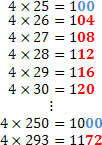THE multiplication is represented by the times sign, which can be: x (2 x 4), asterisk (2 * 4) or period (2. 4). It, which is one of the fundamental operations, is a way of performing the addition of a finite amount of equal numerical terms. O multiplication algorithm is structured as follows:
Factor
x Factor
Product
When we perform an infinite sum of terms with equal parts, we have the multiplication calculation. Look:
5 + 5 + 5 + 5 = 4 x 5
12 + 12 + 12 = 3 x 12
100 + 100 = 2 x 100
The calculation of the multiplication algorithm can be done in two ways:
→ Decomposition algorithm
→ Usual algorithm
decomposition algorithm
In the decomposition algorithm, we must use the decimal numbering system, that is, unit, ten, hundred, unit of thousand, and so on. See some examples:
-
Example 1: Get the solution of: 450 x 5.
Decomposing the first factor: 450 = 400 + 50 + 0
Structuring the Multiplication Algorithm:
400 + 50 + 0
x 5
0 → 5 x 0 = 0
250 → 50 x 5 = 250
+ 2000 → 400 x 5 = 2000
2250 -
Example 2: Make the product of: 110 x 12
Decomposing the first factor: 100 = 100 + 10 + 0
Decomposing the second factor: 12 = 10 + 2
100 + 10 + 0
x 10 + 2
0 → 2 x 0 = 0
20 → 2 x 10 = 20
200 → 2 x 100 = 200
0 → 10 x 0 = 0
100 → 10 x 10 = 100
+ 1000 → 100 x 10 = 1000
1320
usual algorithm
In the usual algorithm, we realize the product without decomposing the factors in written form. We use the knowledge of the decimal numbering system to make the necessary unit conversions in relation to the so-called “up one”. Take a look at some examples:
-
Example 1: Get the solution of: 450 x 5.
4250
x 5
2250
5 x 0 = 0
5x 5 = 25 → As the5of the first factor occupies the order of ten, we have: 50 x 5 = 250. For this reason, we must add 2 to the hundred of the answer of the product of the multiplication of 5 x 4.
5x4= 20 → The number 4it is a factor in the order of hundreds. We must add 2 to product 20 to get 22.
-
Example 2: Make the product of: 110 x 12
110
x 12
+ 220
110
13202 x 0 = 0
1 x 2 = 2
2 x 1 = 2
1 x 0 = 0→ We put this answer in order of tens because the number 1 occupies the position of tens.
1 x 1 = 1
1 x 1 = 1
By Naysa Oliveira
Graduated in Mathematics


